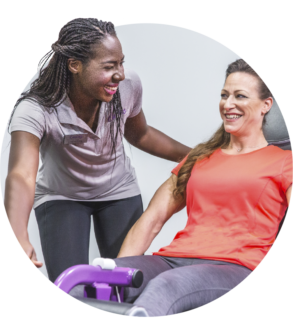Treating Sore Muscles After Your Workout—Workout Recovery Tips
The day after a tough workout, your muscles talk to you. They may tell you they are annoyed by being stiff and sore, but they are also thanking you and reminding you they got a good workout.
No matter what your age or fitness level, you are at risk for sore muscles after a workout. Sore muscles can be discouraging to some women and prevent them from returning to the gym for their next exercise session. But if you understand what causes sore muscles after a workout and you know how to deal with sore muscles, you won’t let them get in the way of your fitness routine.
If you have ever worked out, chances are, you’ve experienced what’s called delayed onset muscle soreness (DOMS). Delayed onset muscle soreness is extremely common, and in most cases, a good sign—it means your muscles are responding to the exercise and getting stronger. The more your body adapts, the less sore you will feel.1
What causes muscle soreness?
There’s a difference between pain from an injury you sustain while exercising and being sore from working out. When you exercise muscles that haven’t worked out in a while, they respond by getting sore. You are likely to experience this type of soreness when you do a new exercise you aren’t used to or do a familiar exercise too hard. This delayed onset muscle soreness results from small tears to your muscles and surrounding tissues. As a result of these small tears, your muscles become inflamed and sore. The resulting inflammation is how your muscles get stronger. This kind of muscle soreness typically peaks one to two days after exercise and lasts no more than a week.2
It is possible to overwork muscles to the point that the muscle becomes swollen and extremely sore to move and touch. In severe cases, the muscle can become permanently damaged, but this is rare.3
Other causes of muscle soreness include autoimmune diseases like multiples sclerosis and lupus, infections, neuromuscular disorders, and certain medications.4
Acute muscle soreness
Muscle pain you feel immediately after you finish a full body workout is called acute muscle soreness. This type of muscle pain after a workout differs from delayed onset muscle soreness and is more like a burning sensation. It usually goes away soon after you stop exercising. 5
What can you do to prevent sore muscles after a workout?
There are a few things you can do pre and post exercise to prevent delayed onset muscle soreness, including the following:
- Drink plenty of water, before, during, and after your workout
- Warm up before your full body workout, and cool down after
- Use a foam roller after your workout
- Eat a combination of lean protein and carbohydrates soon after you’ve finished exercising
- Use heat therapy after your workout, such as a warm bath or heating pad
- Engage in stretches for sore muscles. Your Curves coach can guide you
Delayed onset muscle soreness is a natural part of exercise and getting in better shape. Muscle soreness helps build muscle and gets your body ready for a higher level of fitness. The more often you get to Curves for your full body workout, the less sore after a workout you will feel. If the pain becomes severe, first reduce the intensity of your exercise or switch muscle groups. If you continue to feel sore from working out, see your doctor. 6
Diet tips for preventing and relieving sore muscles after a workout
In addition to doing stretches for sore muscles, drinking plenty of water, and using heat, here are some dietary changes you can make to prevent getting sore after a workout:
- Take anti-inflammatory supplements, including creatine, omega-3 polyunsaturated fatty acids, and vitamin D
- Eat antioxidant-rich foods, such as tart cherry juice, pomegranate juice, beetroot juice, and watermelon juice 7
- Avoid pro-inflammatory foods, such as fried and sugary foods and processed meats 8
The Curves Circuit
The Curves Circuit combines elements of strength training utilizing our hydraulic equipment and HIIT to deliver a full-body workout that works all muscle groups, ensuring no one muscle group is overworked. Hydraulic equipment allows you to work opposing muscles on the same piece of equipment. This is not only very time efficient, but it also helps create body symmetry and helps to minimize acute muscle soreness and delayed onset muscle soreness.
Click here to learn more about the Curves Circuit.
Sources:
- How To Get Rid Of Sore Muscles After A Workout (womenshealthmag.com)
- How To Get Rid Of Sore Muscles After A Workout (womenshealthmag.com)
- Good and Bad Pain for Athletes | Johns Hopkins Medicine Department of Orthopaedic Surgery
- Muscle Pain: Causes, Symptoms, Treatment, Prevention (clevelandclinic.org)
- Delayed Onset Muscle Soreness (DOMS): Symptoms, Causes, Treatment (healthline.com)
- Muscle Pain: Causes, Symptoms, Treatment, Prevention (clevelandclinic.org)
- Nutritional and Supplementation Strategies to Prevent and Attenuate Exercise-Induced Muscle Damage: a Brief Review – PMC (nih.gov)
- Do pro-inflammatory diets harm our health? And can anti-inflammatory diets help? – Harvard Health








